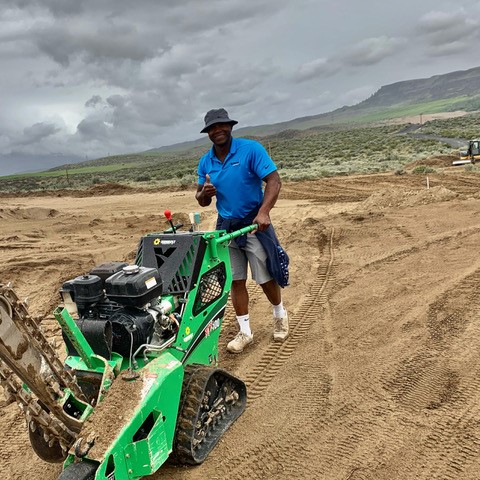Journey of a Lifetime: AJ Bridges finds his way from cornfields to golf course architecture
by Crai S. Bower

Now working as a design associate in the competitive golf course architecture industry, Lloyd “AJ” Bridges had grown passionate about golf having never even hit a ball. Raised in rural Western Kentucky, the closest golf course was two hours from home. However, his father gifted him a left-handed set, unaware that AJ was, though left-hand dominant, a righty.
“My dad, who’d been a high school baseball star in his small town, knew absolutely nothing about golf,” Bridges says. “He’d kindly purchased this used set of Mizunos and I tried them for a while. When I told him I was right-handed, he took them back and found me a used right-handed set.”
Bridges had never set foot on an actual golf course. He developed his passion playing EA Tiger Woods on a PlayStation. He followed Tiger through the entire PGA Tour season, from the Plantation Course at Kapalua to Atlanta Country Club.
A gifted math student, Bridges participated in numerous academic enrichment programs. He began dissecting each golf course’s architectural layout from a mathematical perspective, a practice he follows today. He loved how Rae’s Creek’s presence beneath Augusta’s 12th hole could transform a seemingly benign 8-iron off the tee into a diabolical score and, sometimes, a tournament killer.
He was soon deciphering the math and science of every hole, analyzing fairway slopes, elongated versus pothole bunkers, false green fronts and how a lie could prove advantageous or dangerous within the same 10-foot circle.
“The technology on my video game was good enough in the late ‘90s to distinguish various aspects of each hole,” Bridges says. “I started working backward from a shot to determine exactly how it was formulated. One of my favorite courses was Bandon Dunes because it demanded so many different shots to get around. It’s funny to think today about Bandon because I work with David McLay Kidd, Bandon’s designer.”

By high school, Bridges had begun dreaming about a career in golf design. He was also “playing” a lot of golf, creating imaginary scenarios before hitting a ball from his porch into the cornfield behind his house. After trying to launch his approach shots at the cornstalk, he’d gather the balls up and play another nine “holes.”
“There was a little uphill slope from the back porch,” he recalls. “I would smack those into the cornfield and imagine I was out on a golf course; I would use the farm as a template all the way through the process of getting through the round.”
Bridges’ schoolmates, who told him that golf course design was not a real job, were not his only naysayers. After graduating from Gatton Academy of Math and Science, he enrolled in Western Kentucky University’s “Early Credits” Program, designed for precociously intellectual students. He then transferred to the University of Kentucky to pursue landscape architecture, emphasizing golf course design. His professors tried to steer him elsewhere.
“It was the 2008 recession and a couple of professors told me they didn’t think another new golf course would be built again in America,” he says. “Fortunately, course architect and former Wildcat, Drew Rogers, came and spoke about his career as part of an alumni speaker series. It was the most important lecture I ever attended.”
Inspired, Bridges graduated with a Bachelor of Science in landscape design. He began cold-calling golf course design firms to inquire about jobs. Someone advised him to join a golf construction crew, so he got on with the PGA Frisco project in Texas.

“I did anything that was asked of me, from hauling rocks to surveying fairways and laying seed,” he says.
When DMK Golf Design called offering Bridges a job, he packed his car and left for Bend, Ore., the next day.
“I tell every kid who calls who wants to be me to give it up and find a different dream,” Kidd says. “The odds of success are so incredibly slim I try to dissuade them all I can. Some I can’t. AJ was that kid. He hounded us, was persistent, and had a drive to be seen and a motivation to succeed; we hired him largely because of that drive, although he is pretty darn smart, too. When my peers and I eventually hang it up, it will be AJ and a few others who will fill the void.”
As a design associate, Bridges’ responsibilities span the spectrum of course construction. He follows a site visit by producing readings of topography, laying out holes with coordinates, drafting concepts to put together a full set of construction sets, and composing a variety of sheet sets. There’s also soil testing, water runoff, and native vegetation to consider.
“We also pay close attention to sustainability,” says the 34-year-old, who worked on QuickSands, the short course at Gamble Sands in Brewster, Wash.
Bridges still can’t quite believe he’s in the golf course design business.
“I think I’ve fulfilled my fantasies about what this job would be,” he says. “I was determined to do this, and every moment of clarity about what I’ve accomplished puts a smile on my face.”
Crai S. Bower (@travelcrais on social media) writes dozens of adventure travel articles a year for over 15 publications, including golf stories for Garden & Gun, AARP and Hearst Media, among others. He appears regularly on TSN 690-Montréal as a hockey commentator. Visit his site at flowingstreammedia.net.






